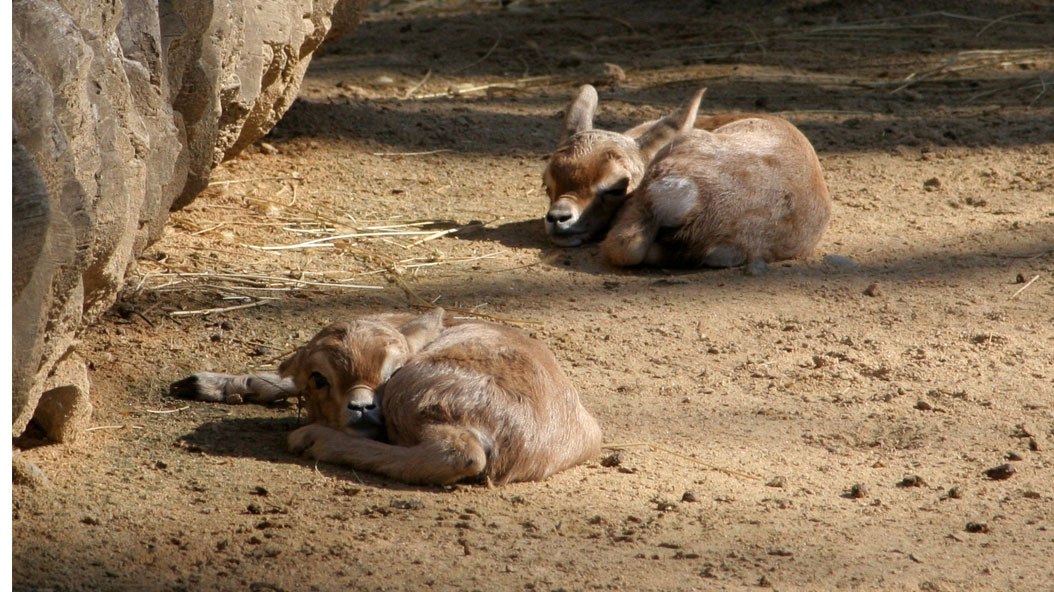Following the instructions of the coordinator of the European Endangered Species Programme (EEP) for the Dorcas gazelle (Gazella dorcas osiris), last year in May a young male of this species arrived at the zoo from Africa, with the mission of renewing the genetic line of the population living in European zoos. The ‘Asturian’ as the caretakers call this new breeding male—because he was born at a breeding centre in Asturias—has done a great job and has already become a father to four males and two females. The new babies live with the rest of the group, made up of their father and another 17 females, who will bear the names of their caretakers.
These new births take place 10 years after the first transfer of these gazelles to Senegal as part of the project to recover this species, carried out by the Almeria Arid Areas Experimental Station, part of the Higher Council of Scientific Research (CSIC per its Spanish acronym) with the support of several European zoos and the close collaboration of the Barcelona Zoo, which has provided specimens, funding and veterinary and educational advisory services. The future of the Dorcas gazelle, which has a vulnerable status in its original habitats in the deserts and steppes of North Africa, is now more promising. There are plans that the new specimens born in European zoos, including the Barcelona Zoo, will soon be used to repopulate more of the original lands of this species in Senegal.

Exploring new projects on the ground
The group known as the ‘Spanish team’, made up of the Almeria Arid Areas Experimental Station (EEZA), of the Higher Council of Scientific Research (CSIC) and the Barcelona Zoo, which worked jointly and successfully on the project mentioned above for reintroducing the Dorcas gazelle to Ferlo National Park (Senegal), was recently contacted by the FAO with the aim of replicating the same management system on the Koily-Alpha Reserve, in the Mbula region in the northern part of the country. The project is managed as a community reserve by the local population itself. Its objective is to restore local flora and fauna, including the reintroduction of animal species that already disappeared, such as the Mhor gazelle (Nanger dama mhorr), the Dorcas gazelle (Gazella dorcas), the white oryx (Oryx dammah) and the African spurred tortoise (Geochelone sulcata), and trees including the baobab and the koily (Mitragyna inermis), for which the reserve is named. The project’s purpose is to stop the advance of desertification, and is part of the pan-African programme entitled the ‘Grande Muraille Verte’ (Big Green Wall), which covers the entire Sahel, from Senegal to Eritrea.

In February, the Spanish work team—made up of Conrad Enseñat and Hugo Fernández, respectively mammal conservator and veterinarian at our zoo, and team manager Teresa Abáigar from EEAZ/CSIC—were invited by the FAO to participate in a workshop in Senegal, along with all other project partners, including representatives from the local community, the Fulani ethnic group. The visit let them speak of the actions to undertake, as well as to study the characteristics of the small existing enclosure and the possibilities of permanently fencing the reserve, with a potential area of 2500 ha, in an area highly exploited by livestock, which has led to heavy disintegration of the land and the disappearance of species.

The exploration of the reserve, with participation from local eco-guards, consisted of a study of local flora (bushes, trees, herbs) and the identification of fauna by using tracking and the placement of camera traps. Areas of particular importance for the project were also studied, such as temporary flood lands and of scenic interest. Determining the precise current situation of the area is essential for moving forward with the project.
The signing of the agreement with the FAO for this ambitious project is expected to take place this year. As mentioned, it is not limited to the reintroduction of some animals, but also involves restoring animal and plant biodiversity with the involvement of the local population, which will be both financially and culturally benefited with the revival of these traits of their identity. For now, the installation and maintenance of the face is already generating work and the country’s flora and fauna are starting to be protected: a first step!




